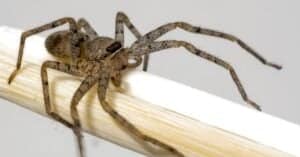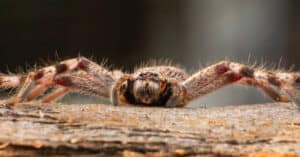Alabama is home to a diverse array of spider species, with over 500 different types recorded across the state.
These arachnids play a crucial role in the ecosystem, helping to control insect populations and serving as a vital food source for many predators.
Among the many spider species found in Alabama, black spiders have garnered particular interest due to their unique characteristics, striking appearance, and, in some cases, potential risk to humans.
In this article, we will explore nine black spider species commonly found in Alabama, delving into their identification features, habitats, and distribution.
Additionally, we will address the question of whether these spiders pose a risk to humans, shedding light on the potential dangers and dispelling myths associated with these fascinating creatures.
#1 Southern Black Widow (Latrodectus mactans)
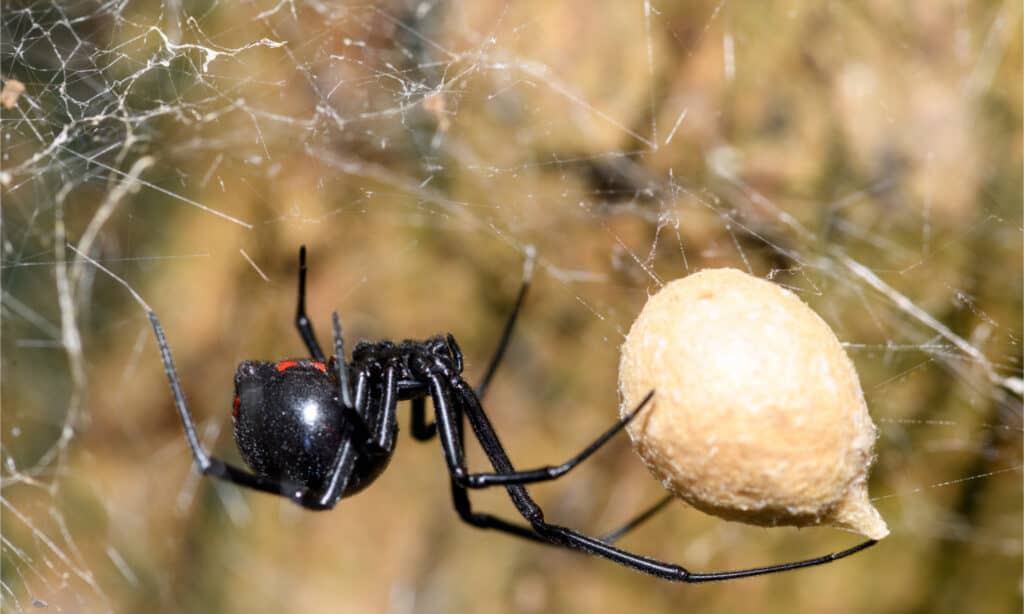
The southern black widow is instantly recognizable, with its distinctive red, hourglass marking.
©Jeff W. Jarrett/Shutterstock.com
This is a highly recognizable spider due to its glossy black body and distinctive red hourglass marking on its abdomen’s underside.
Adult females are typically 0.47-0.63 inches in length, and males are smaller at 0.12-0.24 inches.
Males also lack the characteristic hourglass marking and are often lighter in color.
Habitat and Distribution
Southern black widows are native to the southeastern U.S., including Alabama. They prefer warm and dry environments. They’re often found in areas such as:
- Woodpiles
- Barns
- Sheds
- Garages
They build irregular and messy webs, usually close to the ground, to trap their prey.
Are They Venomous or Dangerous to Humans?
The southern black widow is indeed venomous, with its bite posing a potential risk to humans.
The female’s venom contains a neurotoxin called latrotoxin, which can cause symptoms such as:
- Localized pain
- Muscle cramps
- Nausea
- Vomiting
- Difficulty breathing (in rare cases)
Bites are usually not fatal, but medical attention should be sought immediately if bitten, especially for:
- Young children
- The elderly
- Those with compromised immune systems
But male southern black widows aren’t considered dangerous. Their venom is much weaker, and their fangs are often too small to penetrate human skin.
#2 Northern Black Widow (Latrodectus variolus)
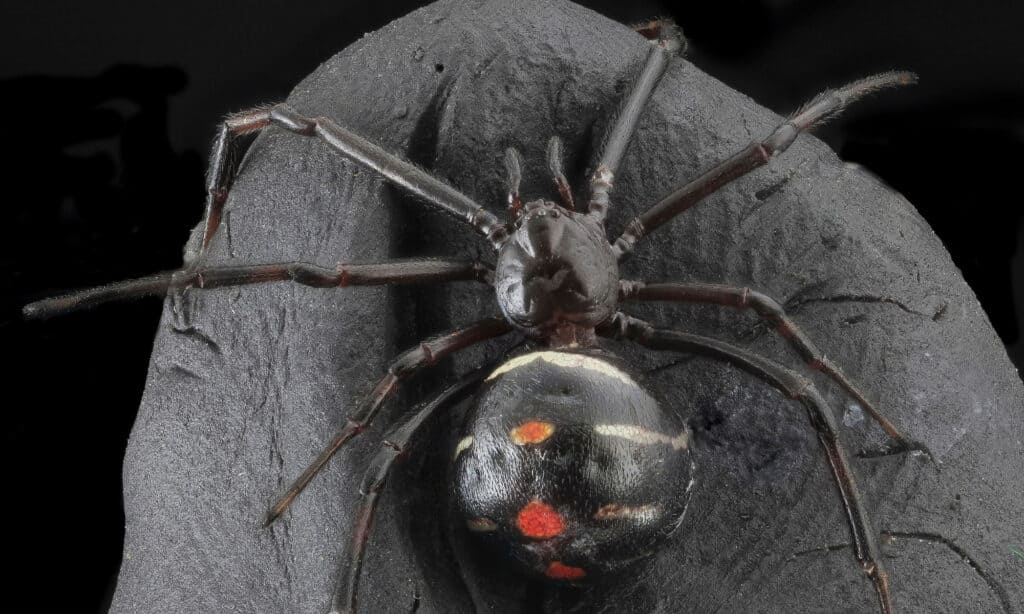
Unlike other black widows, northern black widows have a broken hourglass-shaped marking on their abdomens, which can vary from spider to spider.
©Porco_Rosso/Shutterstock.com
The northern black widow features a shiny black body like its southern counterpart. But the red markings on the abdomen can vary.
While some possess the iconic hourglass shape, others may have two separate red spots or a series of red dots on the upper side of the abdomen.
Females generally measure 0.3-0.6 inches in length, whereas males are smaller, at about 0.1-0.2 inches, and often exhibit lighter coloration and reduced markings.
Habitat and Distribution
The northern black widow is found in the eastern and central U.S., extending its range into Alabama.
These spiders favor habitats such as forests, rock outcroppings, and woodlands, where they construct irregular, tangled webs.
They can also be found in human-made structures like sheds, barns, and garages, particularly in dark and undisturbed areas.
Are They Venomous or Dangerous to Humans?
Similar to its southern counterpart, the northern black widow is venomous. Its bite can be harmful to humans.
The female’s venom contains latrotoxin, which may cause symptoms like:
- Localized pain
- Muscle cramps
- Nausea
- Vomiting
Severe cases may lead to difficulty breathing, but fatalities are rare.
As with the southern black widow, medical attention should be sought promptly in case of a bite.
But the males pose little threat to humans. Their venom is weaker, and their fangs are often too small to penetrate the skin.
#3 False Black Widow (Steatoda grossa)

The false black widow has harmful venom, but unlike other black widow species, their venom is not life-threatening. Still, seeking medical attention is wise if you’re bitten.
©Danie Spreeth Photography/Shutterstock.com
This spider closely resembles black widow spiders, which is why it is named the false black widow.
But there are some key differences in appearance. False black widows have a dark brown to black body, with a round and bulbous abdomen that lacks the hourglass marking found in true black widows.
They also have a faint pattern on the top of their abdomen, which can range from light gray to tan. Adults typically measure 0.2-0.4 inches in length.
Habitat and Distribution
False black widows are native to Europe but have become established in various parts of the U.S., including Alabama.
They thrive in both indoor and outdoor environments, such as:
- Garages
- Sheds
- Basements
- Crawl spaces
- Gardens
- Under rocks
- In wood poles
They build tangled, irregular webs to catch their prey, similar to those of the black widow species.
Are They Venomous or Dangerous to Humans?
While false black widows possess venom, their bites are generally not as dangerous or severe as those of true black widows.
A bite from a false black widow can cause:
- Localized pain
- Swelling
- Redness at the bite site
But these symptoms are usually mild and short-lived.
Although serious complications are rare, it’s still a good idea to seek medical attention if bitten, especially for those who may be more prone to complications or allergic reactions.
#4 Eastern Parson Spider (Herpyllus ecclesiasticus)
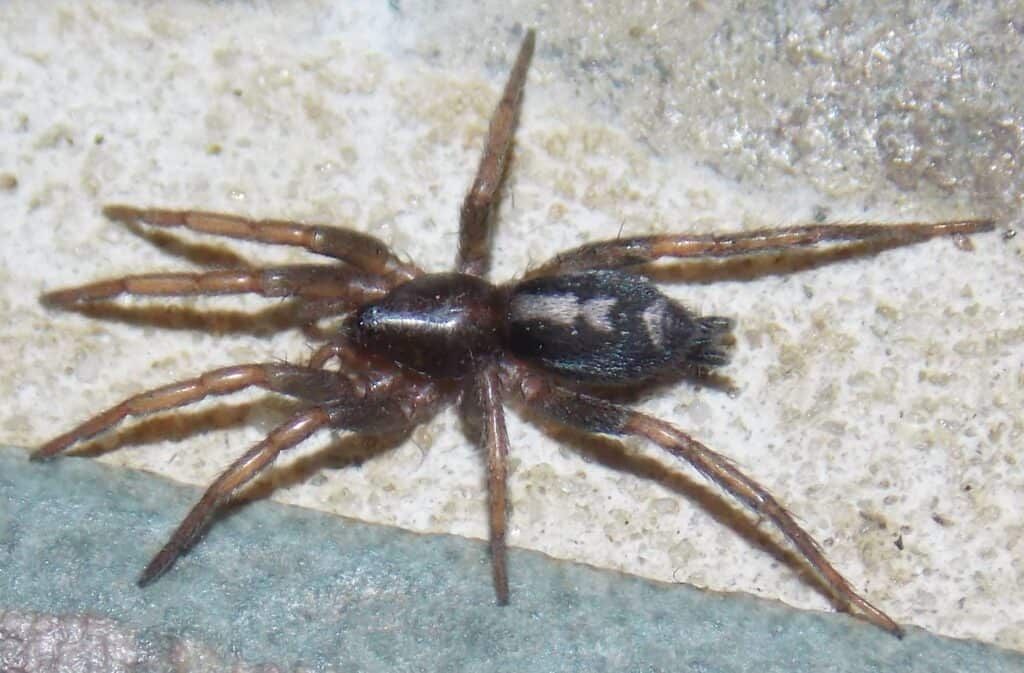
Abdomens on eastern parson spiders are generally grayish-brown with white or cream-colored bands.
©Fyn Kynd/Flickr – License
This spider is characterized by its unique coloration and pattern.
While its cephalothorax (head) and legs are black, its abdomen is grayish-brown with a distinctive white or cream-colored band running down the middle, which resembles a clerical collar, giving it the name “parson.”
Adult eastern parson spiders typically measure 0.2-0.5 inches in length.
Habitat and Distribution
Eastern parson spiders are native to the eastern U.S., including Alabama. They’re primarily ground-dwelling spiders and can be found:
- In leaf litter
- Under rocks
- In wooded areas
Unlike many other spiders on this list, eastern parson spiders don’t build webs to capture prey but instead actively hunt them. Instead, they rely on their speed and agility to catch insects.
Are They Venomous or Dangerous to Humans?
Eastern parson spiders possess venom, but their bites are generally not harmful to humans.
A bite may cause mild symptoms such as:
- Localized pain
- Itching
- Redness
These effects are typically short-lived and don’t require medical intervention.
But it’s still advisable to monitor the bite site and seek medical attention if symptoms worsen or an allergic reaction occurs.
#5 Carolina Wolf Spider (Hogna carolinensis)

The Carolina
wolf spider
is the largest wolf spider in North America.
©Will E. Davis/Shutterstock.com
This is North America’s largest wolf spider species. Adult females measure 0.7-1 inch in length, with males slightly smaller.
They have a robust build and hairy bodies, featuring a brown or black coloration with gray, white, or tan markings on their backs.
The pattern on their abdomen resembles a Union Jack flag, which can aid in identification.
Habitat and Distribution
Carolina wolf spiders are native to the U.S. They can be found throughout the country, including Alabama.
They’re ground-dwelling spiders and prefer habitats such as:
- Grasslands
- Forests
- Agricultural fields
They may also be found in gardens and around human-made structures.
Carolina wolf spiders are nocturnal hunters who don’t build webs. Instead, they actively search for prey. Then, they rely on their exceptional speed and camouflage to ambush insects.
Are They Venomous or Dangerous to Humans?
Carolina wolf spiders possess venom, but their bites aren’t considered medically significant for humans.
A bite may result in:
- Localized pain
- Redness
- Swelling
All these usually subside within a few days.
Medical intervention is typically not necessary, but it’s a good idea to clean the bite area and monitor for any signs of infection or an allergic reaction.
If symptoms worsen or persist, it’s advisable to seek medical attention.
#6 Dark Fishing Spider (Dolomedes tenebrosus)

The dark fishing spider can run across the surface of or dive into the water to catch prey.
©iStock.com/JasonOndreicka
This is a large spider species. Adult females reach 0.6-1 inch in length, and males 0.27-0.5 inch.
Their bodies are dark brown or black, with lighter, contrasting markings on their legs and abdomen.
The pattern on their abdomen often features a series of W- or V-shaped markings along the midline.
Dark fishing spiders have a robust build and long legs, which aid them in their aquatic hunting habits.
Habitat and Distribution
Dark fishing spiders are found throughout the eastern U.S., including Alabama.
They prefer habitats near water, such as:
They’re skilled climbers and can often be found on tree trunks, rocks, and vegetation surrounding water bodies.
Instead of building webs to catch prey. Instead, these spiders actively hunt both aquatic and terrestrial insects, as well as small fish and tadpoles.
Are They Venomous or Dangerous to Humans?
Dark fishing spiders possess venom, but their bites are generally not harmful to humans.
A bite may cause:
- Localized pain
- Redness
- Swelling
These typically subside within a few days. Therefore, medical intervention is usually not necessary, but it’s a good idea to clean the bite area and monitor for any signs of infection or an allergic reaction. If symptoms worsen or persist, it’s advisable to seek medical attention.
#7 Ground Spider (Sergiolus capulatus)
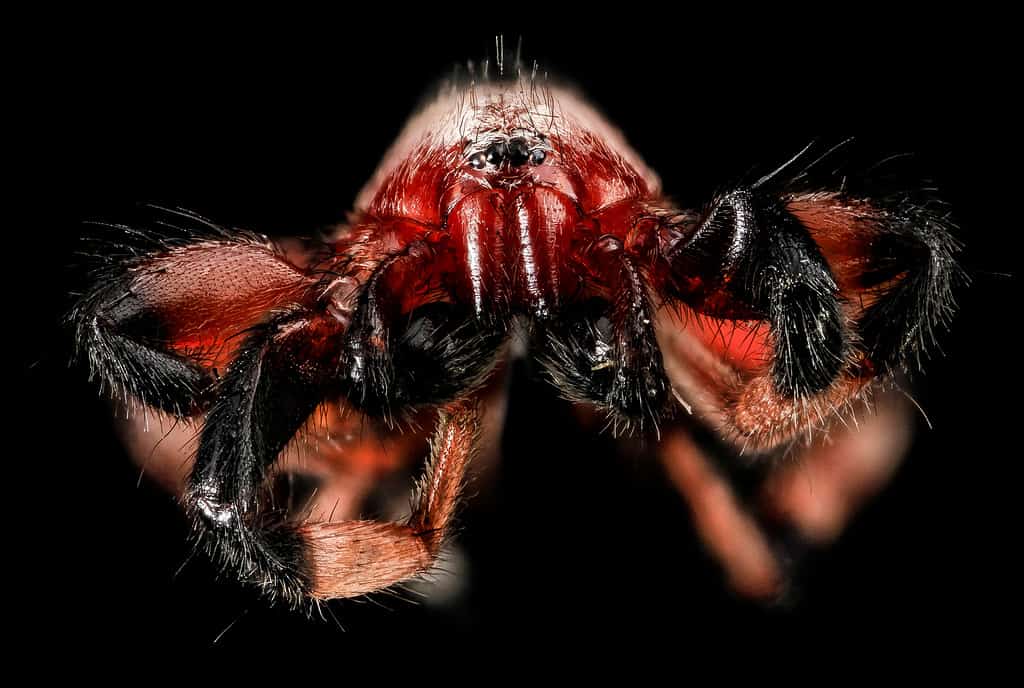
Instead of building webs to catch prey, ground spiders actively hunt for their food.
©lego 19861111/Shutterstock.com
Ground spiders, specifically Sergiolus capulatus, are small to medium-sized spiders. Adult females measure 0.2-0.4 inches in length, with males slightly smaller.
They have a dark brown or black cephalothorax, while their abdomen features a lighter brown color with a distinctive dark pattern resembling an inverted triangle or chevron.
Habitat and Distribution
Ground spiders are widespread throughout the U.S., including Alabama.
As their name suggests, they’re ground-dwelling spiders and can be found in various habitats, such as:
- Forests
- Grasslands
- Gardens
They typically hide under leaf litter, logs, and rocks during the day and come out to hunt at night.
Rather than build webs to catch prey, ground spiders actively pursue insects and other small invertebrates.
Are They Venomous or Dangerous to Humans?
Although ground spiders possess venom, their bites aren’t considered dangerous to humans.
A bite may result in localized pain, redness, and swelling, but these symptoms are usually mild and subside within a few days.
Medical intervention is generally not required. But it’s recommended to clean the bite area and monitor for any signs of infection or an allergic reaction. If symptoms worsen or persist, it’s advisable to seek medical attention.
#8 Black House Spider (Badumna insignis)
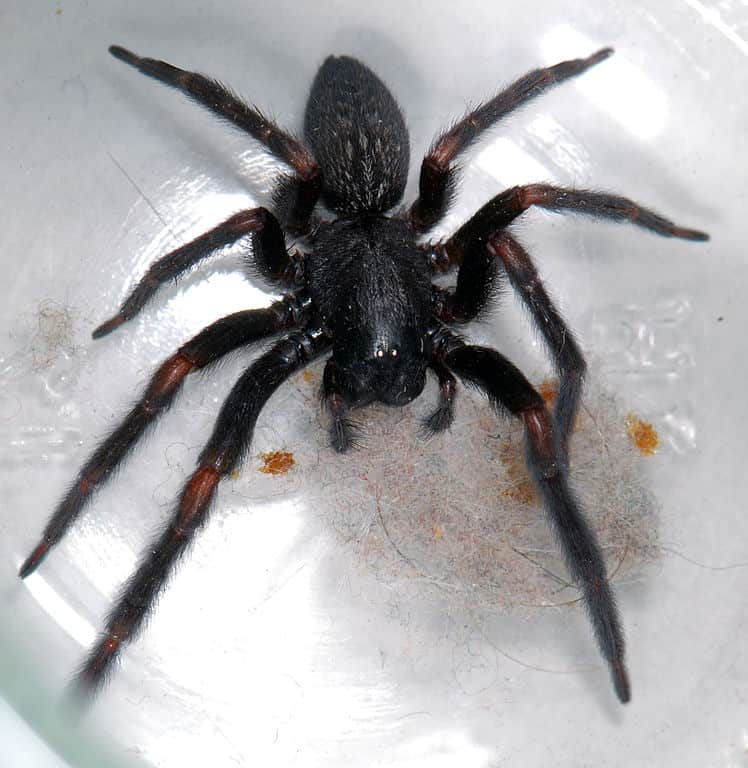
Native to Australia, black house spiders are an introduced species in the United States.
©Peter Halasz (User:Pengo) / CC BY-SA 2.5 – License
Black house spiders are medium-sized, with adult females measuring 0.4-0.6 inches in length and males 0.2-0.3 inches. They have a dark brown or black coloration and a somewhat velvety appearance.
Their abdomen is rounded, and their legs are relatively long and slender compared to their body size.
Habitat and Distribution
Although black house spiders are native to Australia, they have been introduced to other parts of the world, including the U.S.
In Alabama, they can be found in and around human-made structures, such as:
- Houses
- Sheds
- Garages
Black house spiders build intricate, lace-like webs near artificial lights or in the corners of windows and door frames, where they can catch insects attracted to the light.
Are They Venomous or Dangerous to Humans?
Black house spiders possess venom, but their bites are generally not considered medically significant for humans.
A bite from a black house spider may cause:
- Localized pain
- Redness
- Swelling
These usually subside within a few days. In rare cases, more severe symptoms, such as nausea, vomiting, and dizziness, may occur. Medical intervention is typically not necessary. But it’s a good idea to clean the bite area and monitor for any signs of infection or an allergic reaction. If symptoms worsen or persist, it’s advisable to seek medical attention.
#9 Black-and-Yellow Argiope (Argiope aurantia)
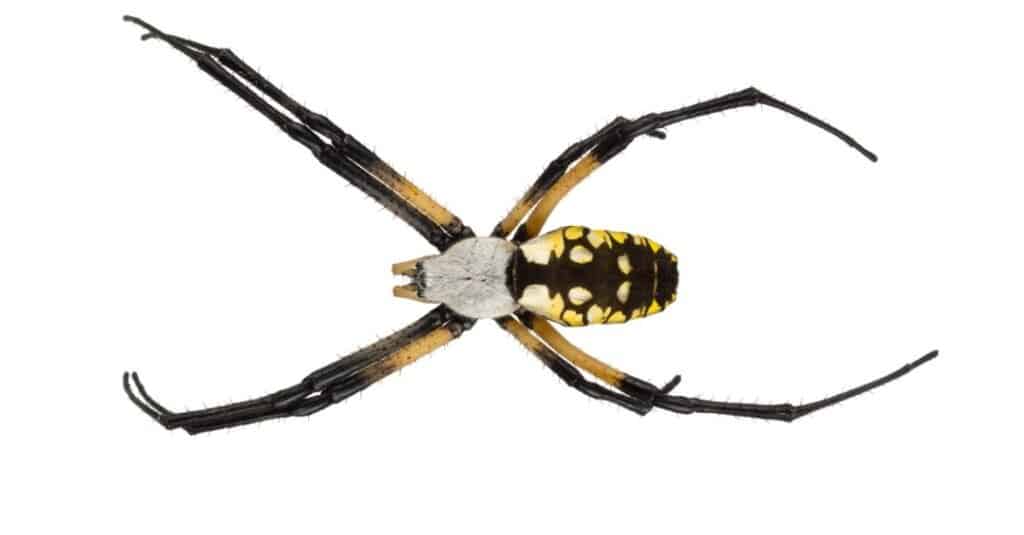
The black-and-yellow argiope has several names, including the writing spider and the
yellow garden spider
, and is a large and striking species.
©iStock.com/DianaLynne
Adult females measure 0.75-1.1 inches in length, and males 0.2-0.35 inches. They have a black cephalothorax and a brightly colored abdomen featuring black, yellow, and white patterns. Their long legs are also adorned with black and yellow bands.
Habitat and Distribution
Black-and-yellow argiope spiders can be found throughout the U.S., including Alabama.
They are commonly found in gardens, meadows, and fields, where they build large, circular, and vertically-oriented orb webs.
These webs often have a distinctive zigzag pattern called a stabilimentum that runs through the center, which is thought to play a role in prey capture or camouflage.
Are They Venomous or Dangerous to Humans?
While black-and-yellow argiope spiders possess venom, their bites aren’t considered dangerous to humans.
A bite may result in:
- Localized pain
- Redness
- Swelling
But these symptoms are generally mild and short-lived.
Medical intervention is usually not required. But it’s a good idea to clean the bite area and monitor for any signs of infection or an allergic reaction. If symptoms worsen or persist, it’s advisable to seek medical attention.
Key Takeaways
Alabama is home to a diverse array of black spiders, each with its unique features, habitats, and behaviors.
While some of these spiders, like the southern and northern black widows, possess venom that can be harmful to humans, the majority of the spiders on this list pose little to no threat.
By learning to identify these spiders and understanding their ecological roles, residents of Alabama can appreciate the beauty and importance of these creatures in maintaining a balanced ecosystem. Moreover, being aware of potential dangers and adopting safe practices when encountering spiders can help minimize the risk of bites and ensure harmonious coexistence between humans and these fascinating arachnids.
The photo featured at the top of this post is © Dan Olsen/Shutterstock.com
Thank you for reading! Have some feedback for us? Contact the AZ Animals editorial team.




